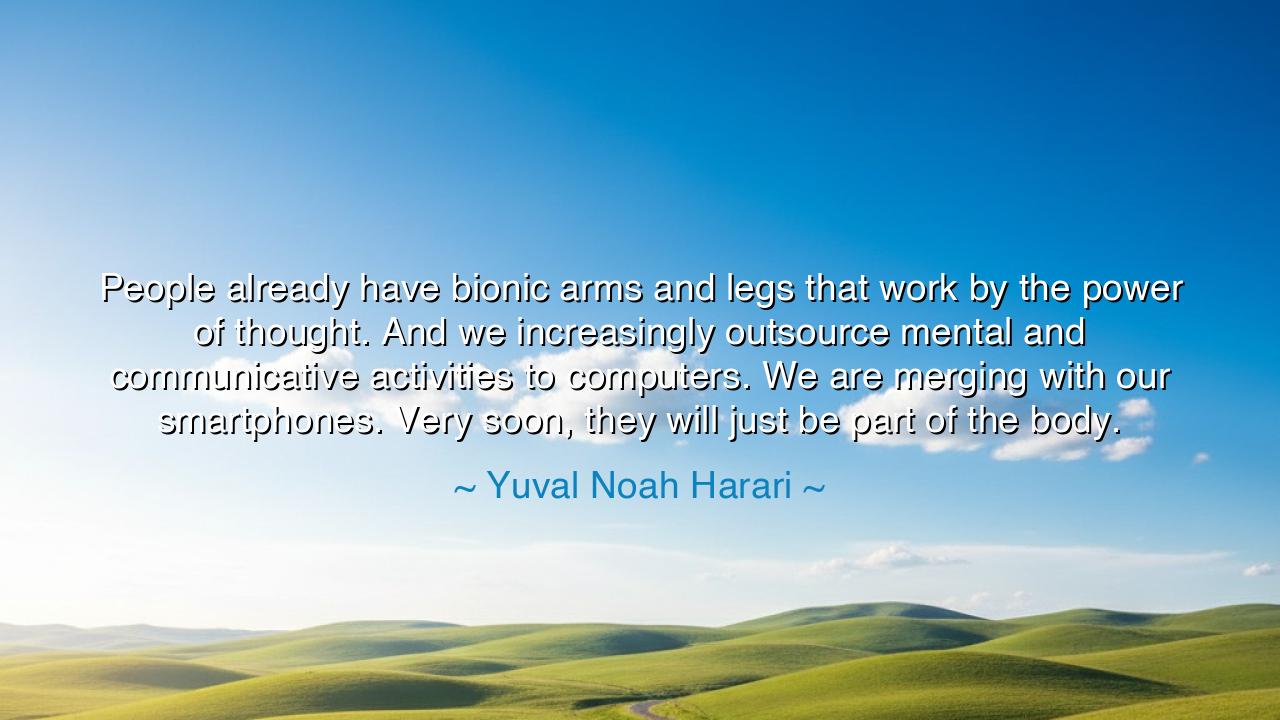
People already have bionic arms and legs that work by the power
People already have bionic arms and legs that work by the power of thought. And we increasingly outsource mental and communicative activities to computers. We are merging with our smartphones. Very soon, they will just be part of the body.






In the journey of humanity, where the quest for progress has been both a blessing and a curse, there are moments when the boundary between nature and technology becomes blurred. Yuval Noah Harari speaks to this profound shift in his statement: "People already have bionic arms and legs that work by the power of thought. And we increasingly outsource mental and communicative activities to computers. We are merging with our smartphones. Very soon, they will just be part of the body." In these words, Harari encapsulates the essence of a future in which technology becomes so deeply intertwined with the human experience that it is no longer something separate but something integral, a second skin that enhances and extends our very being.
To fully understand the weight of Harari’s insight, we must look back at the ancients, who, while lacking the technology we now take for granted, also pondered the relationship between humans and their tools. The Greeks, for instance, saw the mind and the body as interconnected. Aristotle taught that the body was a vessel for the soul, but he also recognized that tools, like the wheel or the plow, were extensions of the human form—extensions that enabled us to conquer nature and expand our capabilities. In their time, the tools were primitive, yet the philosophy was clear: tools amplify our abilities. What Harari envisions is a future where these tools are no longer mere appendages of our capabilities but integrated into our very essence, fundamentally altering what it means to be human.
In Rome, the great engineers of the empire understood this principle well. The Romans did not see their aqueducts and roads as separate from their civilization but as the very infrastructure that sustained it. The Romans were able to conquer vast swaths of land not because of superior military prowess alone, but because they had developed a tool—their technology—that allowed them to manage water, communicate over long distances, and supply their armies efficiently. In the same way, the smartphones and bionic technology of today are tools that extend our reach, but unlike the physical tools of the Romans, these devices are beginning to merge with the human form, becoming an essential part of our daily lives.
Consider the story of Leonardo da Vinci, whose visionary creations bridged the gap between art and engineering. Da Vinci imagined machines that could fly, and though his flying machines never took to the skies in his time, they represented the desire to merge human capabilities with mechanical innovation. Da Vinci’s genius lay in the fusion of mind and machine, an early glimpse into what Harari envisions—a world where the mind and machine are no longer separate but inextricably linked. Today, we see the echoes of this vision in the bionic limbs and brain-computer interfaces that allow individuals to regain movement and control lost through disability.
Just as da Vinci pushed the boundaries of human imagination, today’s scientists and engineers are advancing technology that is revolutionizing the very fabric of what it means to be human. The development of bionic limbs controlled by thought is not just a triumph of engineering, but a profound transformation in the way we think about the body and identity. It is as if we are becoming part of a greater mechanism, our minds linked to a network of machines. Harari’s vision suggests that the future will be one in which our very selves are intertwined with technology, a reality where the line between human and machine fades until we are no longer able to distinguish one from the other.
The lesson embedded in Harari’s words is one of profound significance for future generations. Technology has always been a tool—a means of enhancing human capability, but the challenge we now face is understanding the deeper implications of this new era. If the ancients understood that tools could extend our reach, we must now come to grips with the fact that, as we integrate more deeply with technology, we are reshaping the very nature of our existence. Will this fusion lead to greater freedom and creativity, or will it bind us in ways we cannot foresee? Harari’s warning is a call to awareness, urging us to take control of the tools we are creating and ensure that they serve humanity, rather than overshadow it.
In our own lives, we must remain vigilant. As we develop new tools—whether smartphones, artificial intelligence, or bionic enhancements—we must ask ourselves how these creations will shape our future. Are we truly in control of the technology we develop, or are we allowing it to define us? Just as the Greeks and Romans understood the importance of tools in shaping their worlds, we too must recognize that the tools we create today will become an integral part of our tomorrow. Let us move forward with intention and awareness, ensuring that we use technology to enhance the human experience, rather than lose ourselves in the labyrinth of machines. For it is in balance—between the organic and the mechanical—that we will find the true potential of both.






AAdministratorAdministrator
Welcome, honored guests. Please leave a comment, we will respond soon